יד אבשלום
Yad Avshalom - Absalom’s Tomb - Absalom’s Pillar - Tomb of Absalom
Useful Information
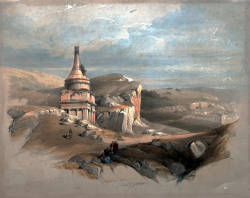
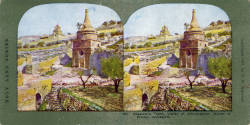
| Location: |
Kidron Valley, Jerusalem.
(31.777221, 35.238856) |
| Open: |
no restrictions. [2021] |
| Fee: |
free. [2021] |
| Classification: |
 Cave Tomb Cave Tomb
|
| Light: | bring torch |
| Dimension: | H=22 m. |
| Guided tours: | self guided |
| Photography: | allowed |
| Accessibility: | no |
| Bibliography: | |
| Address: | Absalom’s Tomb, Tel: +972-2-627-5050. |
| As far as we know this information was accurate when it was published (see years in brackets), but may have changed since then. Please check rates and details directly with the companies in question if you need more recent info. |
|
History
| 1st century | tomb erected. |
| 1925 | area around the tomb cleaned and stone piles removed. |
| 2003 | 4th century Greek inscription detected on the facade. |
Description
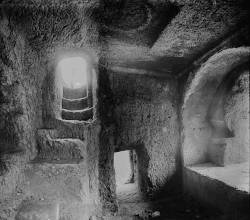
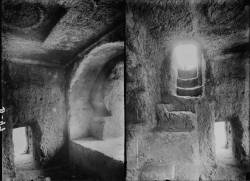
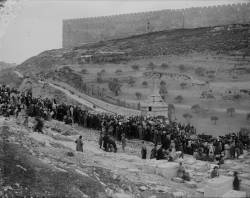

יד אבשלום (Yad Avshalom) or the Tomb of Absalom is also called Absalom’s Pillar. The reason is, that it was cut from the rock and looks like a square tower with a round upper part and a conical, concave roof. It was built in the 1st century in the Kidron valley, known in the Bible as the Valley of Jehoshaphat, east of Jerusalem city center, between the city and the Mount of Olives. It is one of four graves at this location. Traditionally it was ascribed to Absalom, the rebellious son of King David of Israel who lived around 1000 BC, hence the name.
Absalom was King David’s third and favorite son. The Bible tells about the mutiny of Absalom against his father three thousand years ago. King David was unwilling to fight against his own flesh and blood, so he asked Joab, his general, to defeat the mutiny but keep his son alive. Joab succeeded in suppressing the rebellion. Absalom was very proud of his long and beautiful hair, but while escaping on a donkey, his hair was trapped between the branches of a large tree, and thus he was caught and killed by Joab. One of the weird parts of the Bible, as Joab killed him when he was helpless, despite King David’s wish. David mourned his beloved son, although he caused a brief but bloody civil war. According to the Bible Absalom built for himself a memorial pillar in the King’s Valley near the Mount of Olives, which is why this tomb was associated with Absalom for centuries. But he was never buried here, according to 2 Kings 18:17 he was denied a royal burial and thrown into a pit in the forest of Ephraim, with stones piled over his body.
However, the grave was dated by archaeologists to be almost 1,100 years younger. It was built in the 1st century and survived the destruction of Jerusalem by the Romans in 70, in which the temple and many other Judean monuments were destroyed. As a result it became by far the grandest surviving tomb in the Kidron valley and was misidentified as Absalom’s Monument. Who originally built it and if he was buried here is unknown. An inscription tells that “This is the tomb of Zachariah, the martyr, the holy priest, the father of John”, another one citing Luke 2:25 which connects Simeon with the grave. They were written three centuries later during the Byzantine era by Christian monks residing in Jerusalem.
According to rather recent theories it could be the tomb of Herod Agrippa, the grandson of Herod the Great. Herod Agrippa was the king who ordered the death of James the Apostle and arrested the Apostle Peter. The reasons for this are the similarity to the tomb of Herod the Great, and the fact that he was a friend of the Romans, which explains why his tomb was not destroyed while the others were deliberately quarried.
If it was a church it would be called Monolithic Church, so you can probably call it Monolithic Tomb. The structure was cut from the limestone with sculpted facade and is freestanding. The lower part, the square tower is massive rock. The upper part, the round tower and roof are higher than the surrounding rock and were created as masonry. It is the largest and most famous of the "famous" four tombs at this location. The tomb is located at a cobblestone trail and the outside is freely accessible, though it is not possible to enter. The upper part of the monument is mostly hollow, with a small arched entrance on the south side set above the seam area. A short staircase leads down into the burial chamber carved out of the solid rock. The square chamber has arcosolium graves on two sides and a small burial niche. As the entrance is high above the ground, it is not accessible.
On the rear wall of the small square which was created by the sculpting of the pillar, are the openings of another grave. This is the Maarat Yehoshafat (Cave of Jehoshaphat) or Tomb of Jehoshaphat. It was probably built at the same time, but obviously not earlier. The cluster of burial caves has eight chambers. The entrance to these caves is closed with an iron gate.
 Search DuckDuckGo for "Absalom’s Tomb"
Search DuckDuckGo for "Absalom’s Tomb" Google Earth Placemark
Google Earth Placemark The Mystery of “Absalom’s Tomb” (visited: 16-DEC-2021)
The Mystery of “Absalom’s Tomb” (visited: 16-DEC-2021) Index
Index Topics
Topics Hierarchical
Hierarchical Countries
Countries Maps
Maps